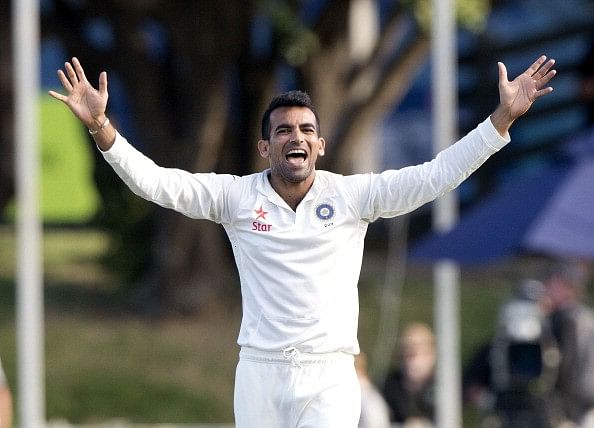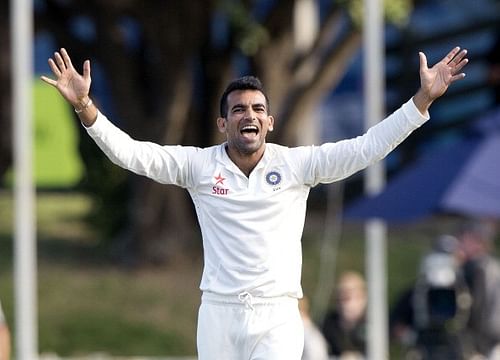
Zaheer Khan - A rare well-kept promise
For a while, the nation held on to the image of Kapil Dev receiving the 1983 World Cup; for a long while. Javagal Srinath came along and showed India possessed ‘decent’ fast bowlers as well, even as Kapil limbered along to the world record Test wickets’ tally. But then, during the entire 90s, India was like a guest to a posh wedding, wearing the best dress in the closet, still nearly not elite enough.
The year 2000 changed everything. The match-fixing saga was behind us. India had its first foreign coach. India picked the most ferociously aggressive captain in its history. India unearthed two gems in one tournament. One of them, Yuvraj Singh, developed a cult following almost immediately, thanks to the fearlessly fresh 84 against Australia in Nairobi.
But anyone who watched the ICC Knockout Trophy in Nairobi will remember those three words that appeared when Zaheer Khan came on to bowl. He debuted against Kenya picking up three wickets, but it was the second match that announced him to the world. These words will forever be etched in Indian fan’s mind, for it was historic, it was never seen before for an Indian bowler – Left Arm Fast.
Zaheer was a rare promise for a nation that despite its batting treasure-troves always envied its neighbour for the bowling gems it unearthed. India would always be that peeking neighbour wistfully looking at Wasim Akram and Waqar Younis, the Sultans of Swing, as Pakistan dominated the 90s’ decimating the best batting line-ups with ‘reverse swing’, a term that was still an esoteric addition to cricketing lingo.
And in a career that spanned more than a decade, Zaheer kept his promise, the promise his swinging full toss that clattered into Steve Waugh’s stumps made to a nation that thirsted for a real fast bowler. An occasional slogger, who won India a few games with the bat, Zaheer walked and talked like a leader, forming a brilliant partnership with all his captains and assisting them as the bowling leader, a trait that will definitely see him in many a coaching role as time progresses.
The Career Numbers
A customary glance at Zaheer’s numbers reveals some important aspects of his contribution.
- With 311 wickets in 92 Tests at an average of 32.94 and a strike-rate of 60.40, he was one of the most menacing contemporary fast bowlers from the sub-continent (not just India)
- With 207 wickets in 54 Tests away at an average of 31.47, he was terrific away from home.
- With 149 wickets in 38 Test wins, Zaheer averaged 25.77 showing how his presence helped India pull off a lot of wins, home and away – an unbelievable Test win percentage of 41%. That was his value to the team. (India lost 27 and drew the remaining 27 with Zaheer in the team).
- With 282 wickets in 200 ODIs at an average of 29.43 and an economy of 4.93, Zaheer was truly world-class also taking home six Man of the Match Awards, a rarity for fast bowlers from the sub-continent.
- With 188 wickets in 135 ODIs away from home, at a sub-30 average, Zaheer was India’s chief weapon of destruction in ODIs outside India.
- With 194 wickets in 117 ODI wins at 23.75, Zaheer was an impact player in India’s ODI wins. He lost only 72 games comparatively where his average dropped to 45.44, but still picking more than a wicket per ODI.
- With 44 wickets in 23 World Cup matches at an average of 20.22 and an economy of 4.47, Zaheer proved himself as a big match player, a critical presence in the 2003 World Cup runner-up team and the 2011 World Cup winning team, when he picked up a whopping 21 wickets, including a wicket every match he played and at least two in eight of the nine games. At the ICC Champions Trophy, Zaheer picked up 15 wickets in 9 games at an average of 24.53.
- With 82 wickets in 77 IPL matches, Zaheer was one of the wiliest Indian fast bowlers in the T20 tournament.
The potent force that made India a superpower
A lot has been said and written about the golden generation of Indian cricket, a decade that saw the ‘Fab Four’ of Sachin Tendulkar, Rahul Dravid, Sourav Ganguly and VVS Laxman take India to new heights including overseas series victories and respectable showing on tough tours to Australia and South Africa.
Zaheer was the architect of many a great milestone. His Man of the Series performance with 18 wickets at an average of 20 helped India win in England in 2007. That performance came at the back of a lean period when he was out of the team for the greater part of a year, not so much in favour with Greg Chappell. But, Zaheer learnt two things beautifully, thanks in a large way to his county stint at Worcestershire.
Unlike other Indian bowlers, he learnt not to be carried away on seaming tracks away from home and instead use them to maximise his returns. He also picked up tricks and trades of fast bowling from many greats including Wasim Akram to get wickets on the sub-continent where pitches ground the fast bowlers to death.
On those graveyards, the man MS Dhoni termed ‘most clever fast bowler I know’, used guile and reverse swing efficiently to script India’s best wins, a phase that saw the team reach the No.1 ICC Test ranking. He was the leader of the pack and always behaved that way, constantly nurturing younger bowlers like Ishant Sharma and setting traps and plans to snare the best of the opponents.
Zaheer made several comebacks into cricket, returning leaner and fitter each time and scripting memorable wins like Trent Bridge in 2007 when he picked nine wickets. It resulted in him being picked as one of the Five Wisden Cricketers of the Year in 2008. Highlights of his career also include the Natwest Triumph in 2002, when a new-look Indian side with Dravid as the wicket-keeper saw three young players Zaheer, Yuvraj and Kaif become the pillars of Indian success.
Zaheer making top players like Graeme Smith (7 dismissals in 15 innings), Kumar Sangakkara (6 in 15) and Andrew Strauss his bunny (6 in 11) always gave India an edge as their best bowler had a mental hook over the better opponent.
Capable of inspired spells, where he swung the ball either way, sometimes in terribly placid conditions, Zaheer has inspired many contemporary fast bowlers like Anderson, when it came to reverse-swinging the ball in the sub-continental conditions for a consistently long period of time.
India still continues to search for a bowling spearhead who can replace Zaheer in his prime, but such greats don’t come often and when they come, rarely keep the promise. Zaheer, made a rare promise and over a decade, kept it. And for that, Indian cricket has been the richer and will stay indebted!
